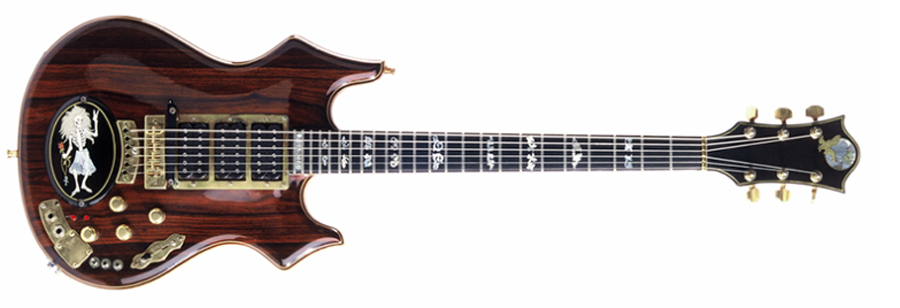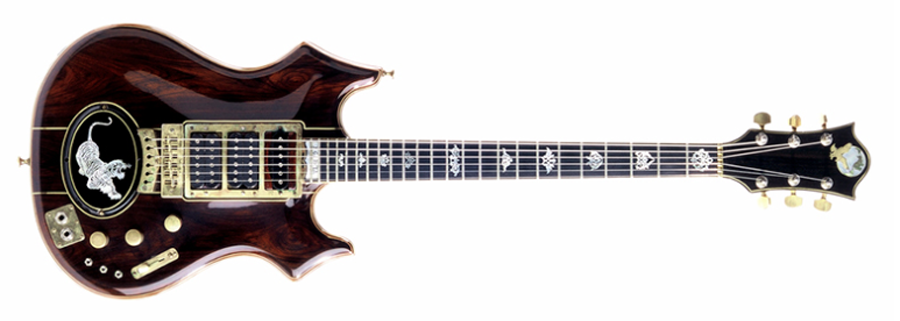Jerry Garcia’s Tiger and Rosebud: A Look at the Last Guitars He Played Onstage

This weekend, the Grateful Dead will reunite for what is being billed as their final concerts.
From July 3 through 5, guitarists Bob Weir, bassist Phil Lesh, and drummers Bill Kreutzmann and Mickey Hart will reunite, along with Phish guitarist Trey Anastasio, for three shows at Chicago’s Soldier Field, the site of the band’s last concert with legendary Dead cofounder Jerry Garcia on July 9, 1995.
With Grateful Dead’s last stand on the horizon, we thought this was a good time to celebrate the genius of Garcia, that band’s heart and soul.
We could talk about Jerry’s playing, but instead we want to look at a pair of instruments that were near and dear to him: the Doug Irwin creations Tiger and Rosebud. These were the last two guitars Garcia played onstage, when he made what would be his final performance 20 years ago at Soldier Field.
Tiger (1979)
In 1972, Garcia began a long association with Irwin when he purchased a guitar called Eagle from the luthier. Garcia liked the guitar so much that he placed a custom order with Irwin. That guitar—dubbed Wolf, for the cartoon wolf sticker Garcia had originally applied below its bridge—was completed in 1973. When Garcia went to pick it up, he was so impressed by it that he placed an order for another custom guitar before leaving.
Wolf became Garcia’s main instrument for the next four years, during which time he asked Irwin to make several modifications, including a buffered effect loop that let him wire his effect pedals to the guitar and bypass them with a switch. Eventually, though, Wolf was replaced by the guitar that Garcia had ordered back in 1973, when he’d received Wolf. That guitar was Tiger, which he received in July 1979.
All the latest guitar news, interviews, lessons, reviews, deals and more, direct to your inbox!
Garcia had given Irwin total freedom with Tiger, and he was not disappointed. The guitar was beautiful, with contrasting layers of tone woods, including cocobolo, maple and vermillion. Detailed pearl inlays on the body’s back and fretboard heightened the guitar’s status as a work of art.
But Tiger was also a testament to Irwin’s technical innovation. The guitar’s coil-tap switches, five-position pickup selector, unity gain buffer, effect loop and other controls gave Garcia the freedom to craft a broad range of tones from the DiMarzio pickups, which included Dual Sound humbuckers in the middle and bridge positions and an SDS-1 in the neck (the Dual Sounds were replaced in 1982 with DiMarzio Super IIs).
“There are 12 discrete possible voices that are all pretty different,” Garcia said of Tiger’s electronics. That tonal power is the reason Tiger was his main guitar for the next 11 years, a continuous run longer than that of any other guitar Garcia played.
Rosebud (1990)
Rosebud was Tiger’s replacement, and Garcia considered it to be Irwin’s masterpiece. While it bore similarities to Tiger, it featured a very different complement of electronic components. These included three humbuckers and a Roland GK-2 hexaphonic guitar synth pickup. Irwin mounted the GK-2’s MIDI and synth controls on the guitar for ease of use. The guitar also had hollow body cavities that reduced its weight by two pounds.
Rosebud’s MIDI features were key to its versatility. Garcia had begun using guitar synths in the Eighties when he installed a Roland hexaphonic pickup on his Wolf guitar. In Rosebud, Garcia finally had one instrument with all the features he’d sought, allowing him to play a broad range of guitar tones as well as external sounds via MIDI.
Rosebud was eventually succeeded by a replica of Tiger called Lightning Bolt, built by luthier Stephen Cripe. The guitar takes its name from the Grateful Dead lightning bolt, which adorns the cover plate below the bridge. But when it came time for the Dead to play Soldier Field in Chicago on July 9, 1995—Garcia’s last gig with the group—Lightning Bolt was in the shop for repairs. In its place was Rosebud. When the guitar began to suffer technical problems midway through the show, Garcia pulled out Tiger, playing his last notes onstage with the guitar that had been with him longer than any other instrument.


Christopher Scapelliti is editor-in-chief of Guitar Player magazine, the world’s longest-running guitar magazine, founded in 1967. In his extensive career, he has authored in-depth interviews with such guitarists as Pete Townshend, Slash, Billy Corgan, Jack White, Elvis Costello and Todd Rundgren, and audio professionals including Beatles engineers Geoff Emerick and Ken Scott. He is the co-author of Guitar Aficionado: The Collections: The Most Famous, Rare, and Valuable Guitars in the World, a founding editor of Guitar Aficionado magazine, and a former editor with Guitar World, Guitar for the Practicing Musician and Maximum Guitar. Apart from guitars, he maintains a collection of more than 30 vintage analog synthesizers.

